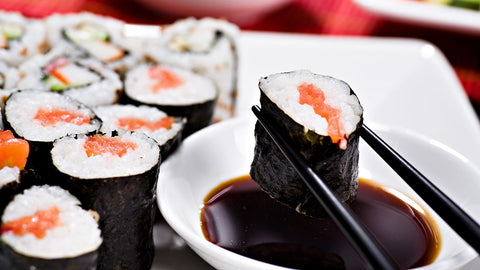Japanese cuisine has worldwide popularity and nothing is more synonymous with Japanese food than sushi. The term sushi is associated with raw fish dishes that we see as healthy culinary art forms that taste great! The forms and traditional types vary greatly. Raw seafood is the foundation for dishes that are consumed and stand on their own merit. Many presentations also include rice, nori (dried seaweed paper) and numerous other ingredients such as vegetables and some seafood that may already be cooked. It is not limited to raw fish and rice. Condiments such as soy sauce, wasabi paste, a distinctive cousin to horseradish, tofu, soy beans, eggs and mayonnaise are often components to some dishes.
Fish is a wonderful source of high quality lean protein. It is low in saturated fats, cholesterol, and carbohydrates. Salmon, mackerel, herring and tuna are rich in omega-3 fatty acids which are linked to many health benefits. Tofu, soy beans, nori, the dried seaweed wrapper commonly used in “rolls”, are all excellent nutrient sources of minerals, calcium, vitamin D, folic acid and antioxidants. Not all ingredients are limited to raw fish. Shrimp, eel, geoduck, crab are often cooked before they are featured in a roll. The wide array of creative rolls and styles seems endless with something to suit any taste. One must be thoughtful about some of the ingredients in some contemporary rolls like cream cheese, fried foods, mayonnaise, soy sauce that greatly increase the calories, sodium and fat contained in your dish. Overall the benefits of enjoying sushi and sashimi are diverse and outstanding.
The risks of eating sushi are very low but are worthy of consideration. The general contamination of seafood with mercury is virtually unavoidable. Unfortunately this neurotoxin contaminates all open waters of rivers, lakes and ocean. Some caution should be exercised in choices of fish variety and quantities consumed by those who are at greatest risk by mercury consumption. Women, who are pregnant, nursing or planning to get pregnant, young children, elderly or people who have a compromised immune system, should limit their consumption of seafood to only 12 ounces per week. Some species of seafood are likely to have higher mercury levels such as tuna, swordfish, shark and mackerel. This does not mean they need to be avoided entirely but consumed in limited quantities emphasizing variety with other kinds that may be lower in mercury content such as salmon, trout, crab and shrimp.
There are other risks of undercooked or raw seafood which remain low if products are handled and stored properly. There are FDA guidelines for the industry which include freezing fish for precise amount of time to kill parasites. Still poor handling or dishonest vendors can provide tainted food that is contaminated with bacteria or parasites. The most common symptoms from eating contaminated raw fish are nausea, vomiting, diarrhea, abdominal pain, headache and fever. One must rely on a reputable dealer and trust your restaurateur to provide sanitary products of high quality. Although eating raw seafood is simply of greater risk than cooked fish, experts agree the health benefits outweigh the risks.
Enjoy the nutritional benefits of a wonderful culinary art with thoughtfulness and peace of mind. Strive for variety and eat sensible portions.

